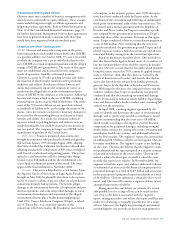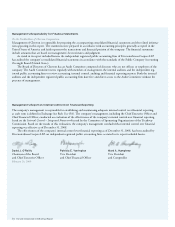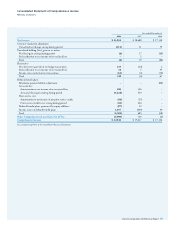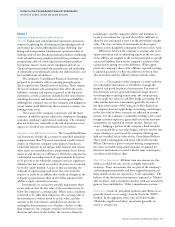Chevron 2008 Annual Report Download - page 55
Download and view the complete annual report
Please find page 55 of the 2008 Chevron annual report below. You can navigate through the pages in the report by either clicking on the pages listed below, or by using the keyword search tool below to find specific information within the annual report.Chevron Corporation 2008 Annual Report 53
of sale of a particular asset or asset group in any period has
been deemed more likely than not, an impairment review is
performed, and if the estimated net proceeds exceed the car-
rying value of the asset or asset group, no impairment charge
is required. Such calculations are reviewed each period until
the asset or asset group is disposed of. Assets that are not
impaired on a held-and-used basis could possibly become
impaired if a decision is made to sell such assets. That is, the
assets would be impaired if they are classified as held-for-sale
and the estimated proceeds from the sale, less costs to sell,
are less than the assets’ associated carrying values.
Business Combinations – Purchase-Price Allocation
Accounting for business combinations requires the allocation
of the company’s purchase price to the various assets and lia-
bilities of the acquired business at their respective fair values.
The company uses all available information to make these
fair value determinations, and for major acquisitions, may
hire an independent appraisal firm to assist in making fair
value estimates. In some instances, assumptions with respect
to the timing and amount of future revenues and expenses
associated with an asset might have to be used in determin-
ing its fair value. Actual timing and amount of net cash flows
from revenues and expenses related to that asset over time
may differ materially from those initial estimates, and if the
timing is delayed significantly or if the net cash flows decline
significantly, the asset could become impaired. Effective
January 1, 2009, the accounting for business combinations
will change. Refer to Note 19 on page 79.
Goodwill Goodwill resulting from a business combina-
tion is not subject to amortization. As required by FASB
Statement No. 142, Goodwill and Other Intangible Assets, the
company tests such goodwill at the reporting unit level for
impairment on an annual basis and between annual tests if
an event occurs or circumstances change that would more
likely than not reduce the fair value of a reporting unit below
its carrying amount.
Contingent Losses Management also makes judgments
and estimates in recording liabilities for claims, litigation,
tax matters and environmental remediation. Actual costs can
frequently vary from estimates for a variety of reasons. For
example, the costs from settlement of claims and litigation
can vary from estimates based on differing interpretations
of laws, opinions on culpability and assessments on the
amount of damages. Similarly, liabilities for environmental
remediation are subject to change because of changes in
laws, regulations and their interpretation, the determination
of additional information on the extent and nature of site
contamination, and improvements in technology.
Under the accounting rules, a liability is generally
recorded for these types of contingencies if management
determines the loss to be both probable and estimable.
The company generally records these losses as “Operating
expenses” or “Selling, general and administrative expenses”
on the Consolidated Statement of Income. An exception
to this handling is for income tax matters, for which ben-
efits are recognized only if management determines the tax
position is “more likely than not” (i.e., likelihood greater
than 50 percent) to be allowed by the tax jurisdiction. For
additional discussion of income tax uncertainties, refer to
Note 16 beginning on page 76. Refer also to the business
segment discussions elsewhere in this section for the effect
on earnings from losses associated with certain litigation,
and environmental remediation and tax matters for the three
years ended December 31, 2008.
An estimate as to the sensitivity to earnings for these
periods if other assumptions had been used in recording
these liabilities is not practicable because of the number of
contingencies that must be assessed, the number of underly-
ing assumptions and the wide range of reasonably possible
outcomes, both in terms of the probability of loss and the
estimates of such loss.
New Accounting Standards
FASB Statement No. 141 (revised 2007), Business
Combinations (FAS 141-R) In December 2007, the FASB
issued FAS 141-R, which became effective for business com-
bination transactions having an acquisition date on or after
January 1, 2009. This standard requires the acquiring entity
in a business combination to recognize the assets acquired,
the liabilities assumed, and any noncontrolling interest in
the acquiree at the acquisition date to be measured at their
respective fair values. It also requires acquisition-related
costs, as well as restructuring costs the acquirer expects
to incur for which it is not obligated at acquisition date,
to be recorded against income rather than included in
purchase-price determination. Finally, the standard requires
recognition of contingent arrangements at their acquisition-
date fair values, with subsequent changes in fair value
generally reflected in income.
FASB Staff Position FAS 141(R)-a Accounting for Assets
Acquired and Liabilities Assumed in a Business Combination
(FSP FAS 141(R)-a) In February 2009, the FASB approved
for issuance FSP FAS 141(R)-a, which became effective for
business combinations having an acquisition date on or after
January 1, 2009. This standard requires an asset or liability
arising from a contingency in a business combination to
be recognized at fair value if fair value can be reasonably
determined. If it cannot be reasonably determined then the
asset or liability will need to be recognized in accordance
with FASB Statement No. 5, Accounting for Contingencies,
and FASB Interpretation No. 14, Reasonable Estimation of the
Amount of the Loss.
FASB Statement No. 160, Noncontrolling Interests in Con-
solidated Financial Statements, an amendment of ARB No. 51
(FAS 160) The FASB issued FAS 160 in December 2007,
which became effective for the company January 1, 2009,
with retroactive adoption of the Standard’s presentation and
disclosure requirements for existing minority interests. This
standard requires ownership interests in subsidiaries held
by parties other than the parent to be presented within the
























